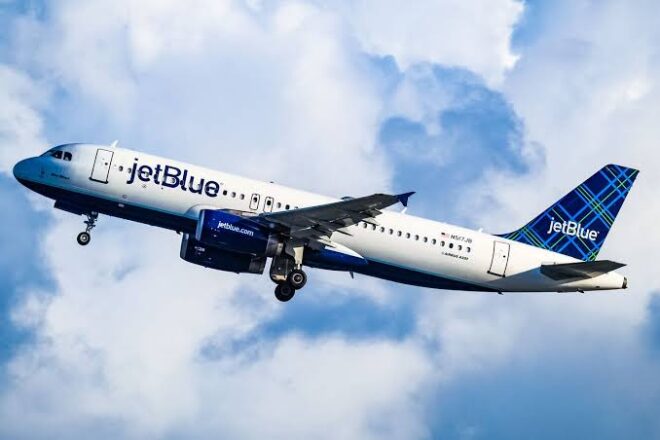
A harrowing experience unfolded on a JetBlue flight en route from New York to the West Coast when a potential smoke alert forced the plane to make an emergency landing in Kansas. The incident, which occurred on JetBlue flight 1189, took place around two hours and 50 minutes into the journey, when the aircraft suddenly began a rapid descent after pilots received a warning of possible smoke in the cargo hold.
Passengers aboard the Airbus A320 experienced a terrifying drop of more than 30,000 feet in under 10 minutes, going from an altitude of 10,000 meters to much lower levels. The swift descent sparked panic among many on board. Some passengers reported hearing a loud bang, adding to the fear and confusion. Seth Odell, one of the travelers, described the moments of panic to NBC affiliate KNSD, stating that “some passengers did start to freak out, and others were crying.” He added, “It was a little bit intense for a few minutes,” underscoring the heightened anxiety that filled the cabin.
Fire crews were immediately dispatched and raced down the tarmac as the plane safely landed at Salina Regional Airport in Kansas. Emergency services were on high alert as the aircraft touched down, prepared for the worst-case scenario, though ultimately, their presence was not needed. Following an inspection by fire crews and airport officials, it was determined that the smoke warning had been a false alarm. A JetBlue spokesperson confirmed that the aircraft had diverted to Salina as a precautionary measure and emphasized that the landing occurred without incident. The spokesperson went on to say, “Upon inspection, we determined the smoke indication presented to our pilots was a false indication.”
Passengers were left stranded at the small regional airport, but local airport workers stepped up to provide assistance. One of the passengers took to Reddit to praise the airport employees, who had reportedly ordered pizzas to ensure those affected had something to eat while they waited for alternative travel arrangements. Despite the disruption and the scary experience, passengers expressed gratitude for the care they received from the local community.
The Federal Aviation Administration (FAA) confirmed that they would launch an investigation into the event, as is standard procedure for incidents involving smoke alerts and emergency landings. However, fire chiefs on the ground in Salina said that no significant issues were found with the aircraft. The false alert remains under review, and officials are working to understand what caused the warning to trigger.
JetBlue’s emergency landing comes amid a series of concerning aviation incidents in recent weeks. Just last week, passengers on a Delta flight to Portland, Oregon, endured a terrifying pressurization problem that left several passengers with bloody noses and stinging ears. The jet, which was carrying 140 passengers, experienced the issue mid-flight, leading to discomfort and fear among those on board. Jaci Purser, a passenger on the flight, described the unsettling moments, recalling how she heard air escape before feeling a bubbling sensation. Other travelers reported similar experiences, with some even suffering nosebleeds as a result of the sudden change in cabin pressure. A Delta spokesperson told *The U.S. Sun* that oxygen masks did not deploy during the incident, though 10 passengers required medical treatment upon landing.
In another alarming aviation incident earlier this month, two jets collided at Hartsfield-Jackson Atlanta International Airport. A Delta aircraft, which was taxiing on the runway, clipped a smaller jet that was set to depart for Louisiana. Thankfully, no one was injured, but the incident caused significant delays and required an investigation into how the collision occurred on the tarmac. This incident highlighted concerns about ground operations and aircraft safety at one of the busiest airports in the world.
The string of recent airline safety concerns, including the JetBlue emergency landing, the Delta pressurization issue, and the Atlanta collision, have raised questions about the state of airline safety protocols. While modern aviation remains one of the safest modes of transport, these incidents serve as a reminder of the potential risks involved in air travel.
As investigations continue into these events, airline passengers are left to wonder what more can be done to ensure their safety at 30,000 feet.